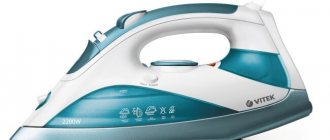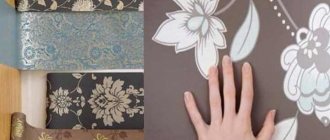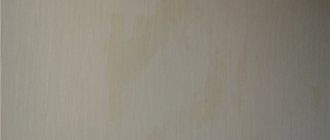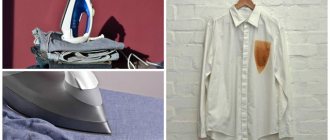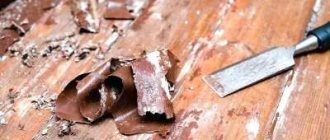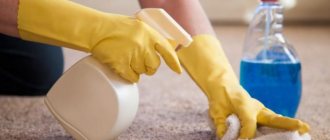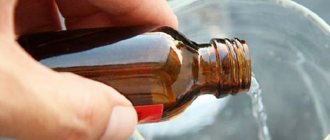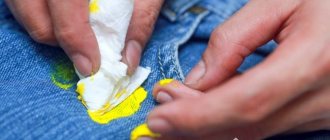Greetings, readers of my blog.
Stains from water and grease, the appearance of abrasions on the surface - all these are the reasons for the loss of the presentable appearance of interior doors. Mostly, stains appear around door handles, as well as at the bottom of the door leaf at the point of contact with the feet. The problem of dirty doors becomes especially urgent with the appearance of children or pets.
If the surface of the canvas is partially contaminated, then removing stains on the door will not be difficult. If the defects affect the entire surface, then you will have to resort to more radical methods.
Gentle ways to remove stains from doors
Every normal housewife strives to maintain order and cleanliness in the house. But some surfaces are very sensitive to cleaning and in order not to make mistakes you should follow my recommendations:
- For the manufacture of interior doors, wood is used directly or indirectly, which is resistant to high humidity. Even for simple cleaning, you should not use a very damp cloth, as this can lead to swelling of the fabric.
- To remove grease stains from the door, you should not use aggressive agents such as acetone, solvent, or alcohol.
- To remove stains, use a soft sponge for washing dishes, not wire brushes. The damaged surface of MDF or laminated doors cannot be restored - you will have to change the canvas.
Safe cleaning tools
To avoid scratching the doors when cleaning, you should use soft and lint-free fabrics, and if there are a lot of small patterns or texture on the surface, then it is better to get a brush with soft bristles.
If the surface has small scratches and cracks, beeswax will do. Deeper scratches can be filled with wax crayons - they are rubbed over the damaged area to fill the void with wax.
Knives, metal scrapers and hard sponges are not suitable for cleaning doors with any coating.
Secrets for removing stains from doors
Different door materials provide different options for removing stains from them. But there are several universal ways to restore the beauty of your door:
- in order to remove brilliant green from the door, use acetic acid
- Marks from a felt-tip pen can be washed off with white spirit or glass washing liquid.
- Some types of stains can be washed off well with vodka mixed with sunflower oil.
- Chocolate or juice stains can be easily washed off with a baby wipe
- The varnish stain can be washed off with a cotton pad slightly moistened with acetone.
- Coffee stains can be easily removed with ammonia.
As you can see, there are a lot of folk methods for removing stains from doors, but there are also professional detergents: Profoam 2000, Sif - paste, Mister Chister, Adrilan, Pronto and many others.
| Types of stains and methods for removing them from doors | ||
| Type of spot | Traditional removal method | Professional product |
| Mold | Dry the door, scrape off the mold with a scraper and treat with | |
| Egg | Mix baking soda and soap, add hot water and apply to the stain. | |
| Old dried spots | We make a mixture of salt and vegetable oil, apply it to the stain and wait for it to dry. Then carefully scrape off | |
| Fingerprints | Wet wipes or rag | Furniture cleaners |
| Scotch tape marks | Nail polish remover | Sticker Remover |
| Marks from a ballpoint pen | Profoam 2000 | |
| Plasticine | Scrape off the remains and wipe with a weak solution of alcohol in a ratio of 1 to 9. | |
| Glue or resin | Resin is removed by heating with a hairdryer | Solvent for glue |
| Varnish | Nail polish remover | |
| Urine | Laundry soap | |
| Jam | Soap + vinegar solution | |
| Wine, chocolate or juice stains | Wet wipe | |
| Pencil marks | Excellent removal with wd-40 | Profoam 2000 |
| Felt pen | Glass cleaning liquid, you can try to erase marks with an eraser | Profoam 2000 |
| Zelenka | Easily washed off with acetic acid | |
| Blood | two tablespoons of table salt + dishwashing liquid | |
| Oily stains | Acetic acid + water, wet wipes | Various cleaning products |
Glass cleaning
Tips for caring for an iron front door will help keep it clean:
To restore the glossy shine of the surface, you need to wash the door with a solution of water and vinegar (1 tablespoon per liter of water is enough).
It is important to note that plastic cannot be rubbed, washed with metal sponges, or rubbed with a brush. This leads to its damage and the appearance of microcracks, into which dirt subsequently gets clogged.
Fighting grease on wooden doors is a necessity, especially if they are located in the kitchen opening. The easiest way is to use folk remedies that are effective and safe to use. You can give preference to the following methods:
Veneer is a thin section of wood covered with MDF sheets . With the help of this manufacturing technology and saving on raw materials, the price of such a door is also reduced.
How can you clean greasy stains from chipboard and MDF structures? I know four effective ways, which are presented in the table:
How to wash wooden doors, because this material is afraid of moisture?
How to remove stains from MDF doors
For the most part, MDF doors with a veneer surface immediately after repair I strongly recommend that you open them with polish. This will protect the surface from the appearance of greasy marks and stains. But if the problem has already appeared, then it needs to be solved.
I will share with you the method that my mother advised me. It has been used since the days of the USSR, when Mister Muscle had never even been heard of :)
To restore the original appearance of MDF doors you will need the following ingredients:
- Potatoes - 1 pc.
- Dry rag
- A little baby powder
The procedure for removing grease stains from a door:
- Cut the potatoes in half and rub the stain until the juice appears
- Leave the stain for 10 minutes
- After the potato juice dries, starch will remain in place of the stain. Remove it with a dry cloth.
- If, after cleaning, white stains remain on the spot, then apply baby talc to them and wipe them thoroughly with a dry cloth.
Using this folk method, you can remove a greasy stain.
The influence of color on the choice of cleaning method
Doors in light shades (milk oak, bleached oak, etc.) are convenient because micro-scratches and dust are almost invisible on their surface.
Light-colored doors are easier to clean than dark ones—there are no streaks left on their surface. For cleaning, you can use both special products and homemade compositions. To clean a light-colored door, you can make a polish at home:
- Three teaspoons of melted granulated wax are mixed with 200 ml of vegetable oil.
- The mixture is thoroughly kneaded until a homogeneous mass is formed and left for 15 minutes to cool to room temperature.
After the polish has cooled, you can begin cleaning: apply the mixture to light-colored doors with a dry, clean cloth, rubbing the surface until perfectly smooth. This homemade composition is suitable not only for cleaning light-colored doors from greasy fingerprints and stubborn dirt, but also for polishing.
Doors of a dark color, including wenge, are more difficult to clean, but at home you can prepare a special polishing composition that will not harm the surface:
- You need to mix 1 teaspoon each of lanolin and turpentine.
- Add 4 teaspoons of soy or other vegetable oil and a few melted beeswax granules.
- The ingredients are mixed until smooth.
The mixture is rubbed into the contaminated area with a soft cloth and wiped gently.
Doors with laminated surface - cleaning methods
Thanks to the protective coating of the laminated film, these doors are easier to clean than others.
Methods for removing greasy stains from doors with a laminated surface:
- Using laundry soap
First, prepare the solution. To do this we need a bar of 72% laundry soap and warm water. We cut the soap into small pieces and prepare a solution.
We soap dirty places with a foam sponge.
Now we wash off the soap stains and wipe thoroughly, leaving no streaks on the door.
IT IS IMPORTANT TO KNOW!
The entire procedure must be done as quickly as possible to prevent water from being absorbed into the door. Otherwise, the door will swell and the laminated coating will peel off.
- Using alcohol
IT IS IMPORTANT TO KNOW!
Don't even think about using pure alcohol!
To begin removing the stain, prepare an alcohol solution. It is prepared in a ratio of 1 to 9, where 1 part is alcohol and 9 parts are water. Wet a cloth in the prepared mixture and apply it to the stain. We wait five minutes and remove the remains with a dry paper towel.
Professional products
Professional products include special formulations from the Cilit, Pronto, Mister Muscle and other well-known brands.
They should be applied according to the instructions on the packaging. Polishes (Pronto, Laska, etc.) will help get rid of fingerprints, grease stains and dirt without leaving streaks on the doors. The point is the professional composition of the polish: during cleaning the product does not penetrate inside, the wooden surface almost does not get wet and the material does not swell. Using polish, you can wash varnished wooden doors without fear of damaging the varnished coating.
There are many similar professional products designed specifically for coating care, which can be found on the shelves of supermarkets and hardware stores. It is only important to choose the right product that is suitable for a specific door covering.
Removing stains on wooden doors
Unfortunately, stains that appear on solid wooden doors require removal from the hinges of the door leaf for their subsequent removal.
Place the removed door on a flat surface, having previously unscrewed the door handles and locks.
Using a solvent, remove the old varnish from the door. Due to the fact that the solvent has a pungent odor, it is better to carry out work outdoors.
After removing the varnish, the wooden door must be sanded using a grinding machine or sandpaper. It is better to use paper with a grain size of 180/220.
Then you need to remove any remaining dust from the door. It is more convenient to use a soft, large brush.
The final stage is coating the door with a new layer of varnish.
Household chemicals to help
Cleaning frosted glass from difficult stains is carried out with compounds from a professional line. Use industrial products and gloves. First, work on the dirt, after which the glass is washed completely.
When choosing cleaning products, you need to make sure that it is not its plastic counterpart. In appearance they are almost identical, in properties they are not.
It is recommended to wash glass with household chemicals once every 2 weeks. The rest of the time, clean with soapy water. The main difficulty is that sandblasting is difficult to wipe dry. They don't use newspapers. Only frequent changes of microfiber or suede cloth will help.
Removing grease stains from painted MDF doors
For the most part, all painted MDF doors are covered with a layer of varnish. Therefore, the use of abrasive materials and aggressive stain removal agents is unacceptable. Damage to the top varnish layer will lead to fading and loss of integrity of the protective layer.
There are two ways to clean painted doors:
- As in the case of laminated chipboard doors, we will use 72% laundry soap. It is necessary to wash the area of contamination with a strong soap solution, then thoroughly rinse off the remaining solution and wipe dry with a paper towel.
- If the first method does not help, then let's try the second. For this we need baking soda and mouthwash. By mixing them we get a “hellish mixture” that must be applied to the stain. Wait a couple of minutes and wash off the remaining stain with water. Wipe the surface dry.
IT IS IMPORTANT TO KNOW!
In order to restore the former shine to the lacquered surface of the door, simply wipe the area where the stain was removed with vegetable oil.
Basic moments
Interior doors, no less than other objects in the apartment, accumulate dirt and dust. This is especially noticeable if the door leaf is not monolithic, but has various carved parts and glass. Traces of dirty hands immediately appear on light-colored doors, and the fittings become covered with a sticky layer of dirt mixed with dust.
Eco-veneer is especially vulnerable to contamination, because by and large, it is just a textured film with which the canvas is covered. Film for eco-veneer is produced in different countries; fairly high-quality material is obtained from Koreans, Japanese, and Italians.
In order for the door to please us with its cleanliness and be pleasant to touch, we will have to take care of it during operation. In addition, blank canvases are not so popular now, because the door is most often an integral attribute of the overall picture of the interior of the room, therefore it must be colorful and beautiful, and therefore clean.
Doors support the interior of the room
Let's highlight the main points in caring for doors:
- It is necessary to devote time not only to washing the door leaf itself, but also to cleaning and adjusting the fittings. If it is loose, you need to tighten it, if it creaks, you need to lubricate it.
- If you have doors made of natural wood or solid wood in your home, it is worth adjusting the microclimate in the room. It is undesirable to allow the temperature to rise above 25°C and the humidity to exceed 70%.
- It will not be possible to hide severe damage to high-quality doors; there is no way to hide scratches or dents, so try to treat the material with care.
- If soiled and stained, try to wash your interior doors immediately; it is better not to wait for the dirt to be absorbed into the structure of the material.
- Old doors that are not of the best quality, or modern eco-veneer, can be additionally protected from dirt by coating them with varnish. Not the smartest solution, but accessible to everyone.
- During repairs, cover the doors with plastic, like other pieces of furniture, to avoid getting dirty.
Doors are made from different materials: PVC, laminated, eco-veneer, natural veneer, solid wood. Ideally, each material has its own detergent composition, or just clean water. To properly wash and clean fabrics, you can use the following tips:
When cleaning, pay attention to door hardware
- Many modern doors are equipped with glass; to wash them without smudges and streaks, add a couple of drops of ammonia to the water, provided that they are not frosted.
- Metal parts on the doors can be easily washed with ordinary soapy water.
- To avoid damaging the door covering, it is best to wash and wipe the surface with a soft cloth, such as suede or microfiber.
- Dust will certainly accumulate on decorative inserts and carved elements of doors, so do not forget to remove it during weekly cleaning of the house.
- When finishing washing the door leaf, pay attention to the fittings, wash and disinfect the handles.
Most often, the door fails or loses its aesthetically attractive appearance through our fault, due to poor handling and lack of proper care. But we want the door to serve us faithfully for a long time, so we choose the appropriate product and wash it.
How to clean laminated chipboard panels
There are four ways to wash stains from chipboard panels:
- Citric acid
Prepare the solution - add two tablespoons of acid to 200 ml of cold water. Mix thoroughly and wash off the stain with the resulting mixture. Wipe the treated area with a dry cloth.
- Using a solvent
A cotton pad should be moistened with solvent and carefully rinse off the greasy stain. After removal, the surface is also wiped with a clean towel.
- Detergent
Add three tablespoons of detergent to half a glass of water. Mix and apply the resulting foam to the stain. Wait 3 - 5 minutes and rinse thoroughly. Wipe dry with a clean rag.
- Baking soda
Mix three tablespoons of baking soda per glass of water. The resulting solution washes off the stain. Then the surface is wiped dry.
How to treat wood and metal surfaces
A wooden door requires meticulous care, as well as high-quality processing during its creation. These factors will help preserve the canvas from moisture, fungus, mold, small pests, and cracking.
Step-by-step processing of wooden canvas from scratch:
- Before starting processing, the door is sanded with fine sandpaper. To eliminate large defects, use a coarse abrasive. In difficult cases, the surface is puttied.
- After preparatory work, it is customary to impregnate the wood with abiotics, which are antifungal and anti-mold agents. They are applied like regular paint with a brush or roller. If the solution is well absorbed, then you can soak the door a second time a day later. The abiotic penetrates deep into the structure and protects the door for many years.
Note: you can putty the door after applying the abiotic.
- When the door is completely dry, it is re-treated with sandpaper.
- Before painting, the canvas is covered with a double layer of primer. Use either wood primer or drying oil. The layers are not applied one after another, you must wait until dry.
- When treating doors with a varnish composition, the coating of primer or drying oil is eliminated and replaced with stain. The number of layers of stain determines how dark the wood will be in the end. The varnish is applied in two layers. The first layer dries for at least 36 hours.
Metal is also a capricious material, and if you haven’t been interested in the condition of your door for a long time, then do it right now. The most common damage to metal is its corrosion, which has many manifestations. For example, corrosion by spots, pitting, through and subfilm, when the destruction of the metal occurs under the coating. How can you treat a surface from rust?
- Clean the surface using wire brushes. This method is suitable for small stains; for thick layers of rust, it is used initially as an auxiliary method. It is not effective, since the degree of cleaning is low and a lot of dust flies in the process.
- Processing with a grinding disc. Suitable for small damaged areas; the surface is processed efficiently if the disc is made of good material. Please note that the disc is erased during the process, and its use requires skill.
- Processing metal with a sandblasting gun. The bottom line is that jets of sand fly out under pressure onto a corrosive surface, which as a result peels off.
- They also use a combination of water and sand, and waterjet processing of metal. Corrosion and previous painting are completely susceptible to strong pressure.
Wax pencils and polish for bare wood and MDF
Scratches and other damage can be repaired on wooden surfaces with wax and polish. Polishes are substances that can add shine to the surface being treated. They are presented as paste-like mixtures or emulsions that have a long shelf life.
To remove a scratch in wood, sand the damaged area with a fine abrasive, then apply soft polishing wax and rub with a cloth. A soft wax pencil is used to treat deep scratches. Pencils have a wide color palette, which allows you to choose the desired tone. After repairing the damage, remove any remaining wax with a dry cloth. The surface is coated with varnish or paint to match the door.
When working with MDF profiles, wax pencils are simply irreplaceable when you need to cover the gap at the joints of the profile.
Pros of using wood correctors:
- Operational restoration
- Variety of color palette
- Versatility
- Durability due to increased material adhesion and water resistance.
